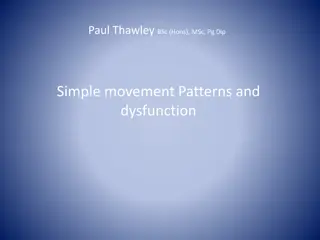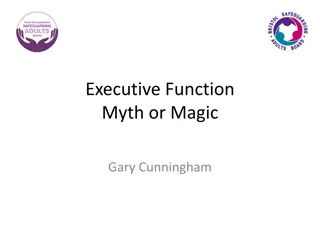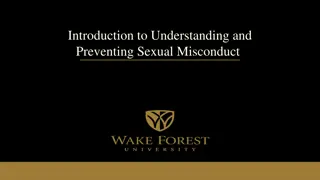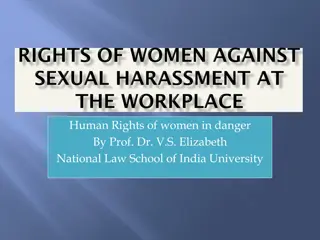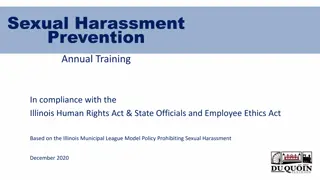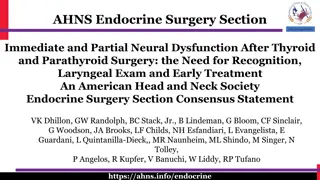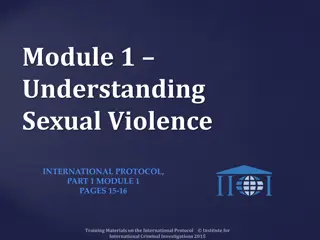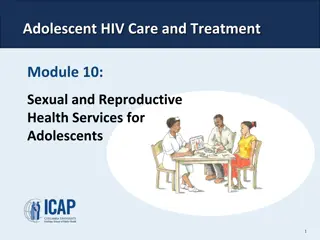Understanding Sexual Dysfunction and Associated Factors
Sexual dysfunction encompasses a range of issues that can affect individuals, with causes including psychological, neurological, hormonal, and relationship-related factors. Evaluating sexual problems involves considering duration, context, and frequency. Psychological causes, such as anxiety and stress, can contribute significantly to sexual problems. Relationship issues, loss of trust, poor communication, conflicting sexual expectations, and lack of respect are common factors. Male sexual dysfunction and disorders of desire, influenced by psychological factors like anxiety and depression, are also discussed.
- Sexual Dysfunction
- Psychological Causes
- Relationship Issues
- Male Sexual Dysfunction
- Disorders of Desire
Download Presentation

Please find below an Image/Link to download the presentation.
The content on the website is provided AS IS for your information and personal use only. It may not be sold, licensed, or shared on other websites without obtaining consent from the author. Download presentation by click this link. If you encounter any issues during the download, it is possible that the publisher has removed the file from their server.
E N D
Presentation Transcript
What Is a Sexual Problem? How Common Are Sexual Problems? Evaluating a Sexual Problem: A Three- Dimensional Model Duration: Primary or Secondary Context: Global or Situational Frequency: Partial or Total
Sources of Sexual Problems: Neurological Hormonal Vascular Use and Abuse of Alcohol and other Recreational Drugs SSRIs (Selective Serotonin Reuptake Inhibitors) Psychological
Sources of Sexual Problems: Psychological Causes Frequency Types Fear Of . . . Anxiety About . . . Guilt Over . . . Stress Due to . . . Other Psychological Causes
Sources of Sexual Problems: Psychological Causes (cont.)
Sources of Sexual Problems: Relationship Issues Loss of Trust Poor Communication Anger and Resentment Conflicting Sexual Expectations Lack of Respect Loss of Love Interactions Among the Above 6 Factors
Disorders of Desire Psychological causes A general increase in anxiety, depression, or anger may reduce sexual desire in both men and women Fears, attitudes, and memories may contribute to disorder of sexual desire Certain psychological disorders, including depression and obsessive-compulsive disorder, may lead to sexual desire disorders
Disorders of Desire psychological causes Attitudes, fears, and psychological disorders that contribute to sexual desire disorders occur within a social context Many sufferers of desire disorders are feeling situational pressures Examples: divorce, death, job stress, infertility, and/or relationship difficulties Cultural standards can set the stage for development of these disorders The trauma of sexual molestation or assault is especially likely to produce disorder of sexual desire
Disorders of Excitement Psychological causes Any of the psychological causes of hypoactive sexual desire can also interfere with arousal and lead to erectile dysfunction For example, as many as 90% of men with severe depression experience some degree of ED One well-supported cognitive explanation for ED emphasizes performance anxiety and the spectator role Once a man begins to have erectile difficulties, he becomes fearful and worries during sexual encounters; instead of being a participant, he becomes a spectator and judge This can create a vicious cycle of disorder of sexual desire where the original cause of the erectile failure becomes less important than the fear of failure
Disorders of Orgasm Early Ejaculation Characterized by persistent reaching of orgasm and ejaculation with little sexual stimulation As many as 30% of men experience rapid ejaculation at some time Psychological, particularly behavioral, explanations of this disorder have received more research support than other explanations The dysfunction seems to be typical of young, sexually inexperienced men It may also be related to anxiety, hurried masturbation experiences, or poor recognition of arousal
Disorders of Orgasm Delayed Ejaculation Characterized by a repeated inability to reach orgasm or by a very delayed orgasm after normal sexual excitement A leading psychological cause appears to be performance anxiety and the spectator role, the cognitive factors involved in ED
A New View of Female Sexual Problems (cont.)
Disorders of Desire Psychological causes A general increase in anxiety, depression, or anger may reduce sexual desire in both men and women Fears, attitudes, and memories may contribute to disorder of sexual desire Certain psychological disorders, including depression and obsessive-compulsive disorder, may lead to sexual desire disorders
Disorders of Desire psychological causes Attitudes, fears, and psychological disorders that contribute to sexual desire disorders occur within a social context Many sufferers of desire disorders are feeling situational pressures Examples: divorce, death, job stress, infertility, and/or relationship difficulties Cultural standards can set the stage for development of these disorders The trauma of sexual molestation or assault is especially likely to produce disorder of sexual desire
Disorders of Orgasm- Female Orgasmic Disorder Psychological causes The psychological causes of hypoactive sexual desire and sexual aversion, including depression, may also lead to female arousal and orgasmic disorders Memories of childhood trauma and relationship distress may also be related
Disorders of Orgasm- Female Orgasmic Disorder Sociocultural causes For years, the leading sociocultural theory of female disorder of sexual desire was that it resulted from sexually restrictive cultural messages This theory has been challenged because: Sexually restrictive histories are equally common in women with and without disorders Cultural messages about female sexuality have been changing while the rate of female disorder of sexual desire stays constant Researchers suggest that unusually stressful events, traumas, or relationships may produce the fears, memories, and attitudes that characterize these dysfunctions Research has also linked orgasmic behavior to certain qualities in a woman's intimate relationships (such as emotional intimacy)
Disorders of Sexual Pain Vaginismus Characterized by involuntary contractions of the muscles of the outer third of the vagina This problem has received relatively little research, but estimates are that it occurs in fewer than 1% of all women Most clinicians agree with the cognitive-behavioral theory that vaginismus is a learned fear response Some women experience painful intercourse because of infection or disease Many women with vaginismus also have other sexual disorders
Disorders of Sexual Pain Dyspareunia Characterized by severe pain in the genitals during sexual activity As many as 14% of women and about 3% of men suffer from this problem Dyspareunia in women usually has a physical cause, most commonly from injury sustained in childbirth Although psychological factors or relationship problems may contribute to dyspareunia, psychosocial factors alone are rarely responsible









